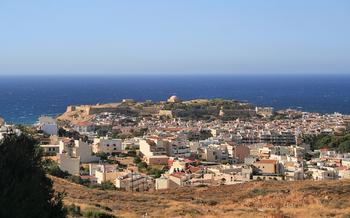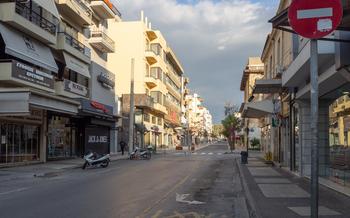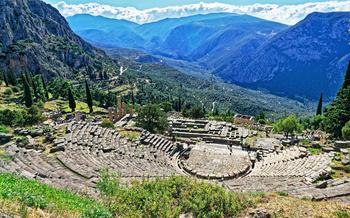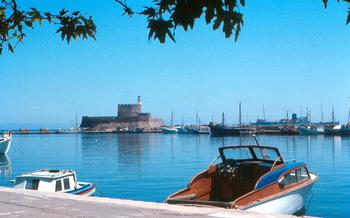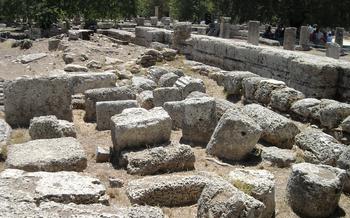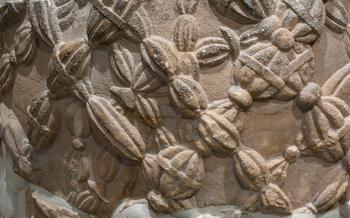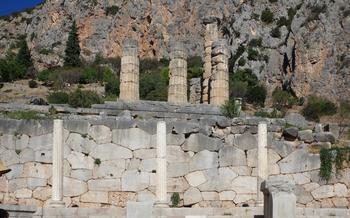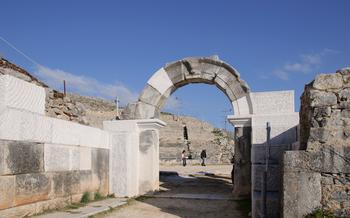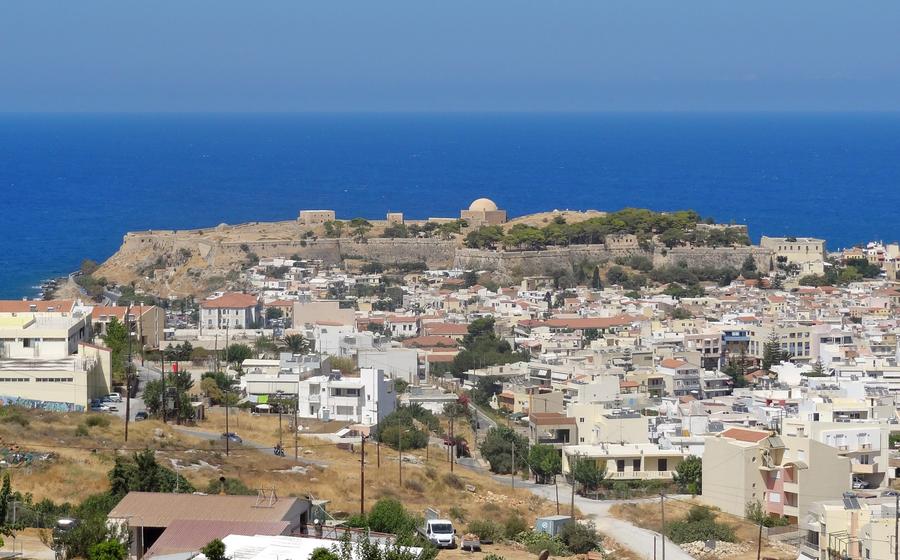
Eleutherna Archaeological Park
- Antiquity of Eleutherna Archaeological Park:
- Location of the Eleutherna Archaeological Park:
- Artifacts and Exhibits
- The Acropolis of Eleutherna
- The Lower City of Eleutherna
- The Necropolis of Eleutherna
- The Olive Press and Oil Production
- The Aqueduct and Water Management
- The Temples and Religious Practices
- The Agora and Civic Life
- The Theater and Performances
- The Hellenistic and Roman Periods
- The Early Christian Basilica
- Insider Tip:
Antiquity of Eleutherna Archaeological Park:
The Eleutherna Archaeological Park, located in the heart of Crete, Greece, boasts a rich history that dates back to the Bronze Age. This ancient city, once a thriving hub of Minoan and Roman influence, has yielded a treasure trove of archaeological discoveries that shed light on its diverse past.
Eleutherna's Minoan roots can be traced back to the 2nd millennium BC, as evidenced by the impressive tholos tombs and remnants of a Minoan settlement. These tombs, with their circular shape and corbelled roofs, provide a glimpse into the burial practices and architectural prowess of the Minoan civilization.
During the Roman period, Eleutherna underwent significant urban development and expansion. The Romans left their mark on the city by constructing an impressive aqueduct, public baths, and a theater, all of which testify to the city's prosperity and cultural significance during this era.
The archaeological excavations at Eleutherna have unearthed a wealth of artifacts, including pottery, jewelry, tools, and sculptures. These artifacts provide valuable insights into the daily life, economy, and artistic traditions of the city's inhabitants throughout the centuries.
Location of the Eleutherna Archaeological Park:
The Eleutherna Archaeological Park is conveniently situated just 12 kilometers (5 miles) southeast of Rethymno, the vibrant capital of Rethymno Prefecture in Crete, Greece. The archaeological park lies in the Mesara Plain, a fertile and historically significant region known for its ancient Minoan settlements. The park's proximity to Rethymno makes it easily accessible for visitors who wish to explore the rich historical and cultural heritage of the region.
The park can be reached by car via a well-maintained road that winds through the picturesque countryside, offering stunning views of the surrounding landscape. The journey from Rethymno takes approximately 20 minutes and provides a glimpse of the island's natural beauty. The park's location amidst rolling hills and olive groves creates a serene and evocative setting for exploring the remnants of this ancient city.
Artifacts and Exhibits
Among the many artifacts uncovered during excavations at the Eleutherna Archaeological Park, several stand out for their significance and beauty. In the on-site museum, visitors can admire a collection of pottery, tools, jewelry, and other objects that provide a glimpse into the daily lives of the ancient Eleuthernians. A notable highlight is the "Eleutherna Hoard," a collection of gold and silver jewelry discovered in a Minoan tomb. These exquisite pieces, dating from the 16th century BC, showcase the remarkable craftsmanship and artistic sensibilities of the Minoan civilization.
Interactive exhibits further enhance the visitor experience, providing deeper insights into the park's history and culture. Through multimedia presentations, virtual reality displays, and hands-on activities, visitors can explore the ancient city in a more engaging and immersive way. The museum's collection is organized chronologically and thematically, allowing visitors to trace the development of Eleutherna from its humble beginnings as a small settlement to its rise as a prosperous city-state.
The Acropolis of Eleutherna
The acropolis of Eleutherna, perched majestically atop a hill, is the heart of the archaeological park, commanding awe with its historical significance and architectural prowess. Once the fortified citadel of the ancient city, its sturdy walls stand as a testament to the strategic importance of Eleutherna. Within these walls, you'll discover the remains of temples, public buildings, and other structures that narrate the story of a vibrant ancient community.
As you ascend the acropolis, you'll be struck by the sheer magnitude of the fortification walls, which once protected the city from invaders. Their strategic positioning, coupled with the rugged terrain, made Eleutherna virtually impregnable. Among the ruins, you'll find the remnants of temples dedicated to various deities, including Zeus, Athena, and Apollo, showcasing the religious devotion of the Eleuthernians.
The acropolis also boasts the ruins of public buildings, such as the bouleuterion (council house) and the prytaneion (government building), hinting at the political and administrative functions that transpired within these walls. But perhaps the most captivating aspect of the acropolis is the breathtaking panorama that unfolds before you. From this vantage point, you'll be rewarded with sweeping views of the surrounding landscape, dotted with olive groves, vineyards, and the shimmering Mediterranean Sea in the distance.
The Lower City of Eleutherna
Descending from the acropolis, visitors can explore the lower city of Eleutherna, where the ancient inhabitants resided. This area features well-preserved houses and workshops, providing a glimpse into the daily life of Eleutherna's citizens. The residential districts are laid out in a grid pattern, showcasing the city's organized urban planning.
Strolling through the lower city, visitors can admire the remains of houses, complete with courtyards, storage rooms, and living quarters. These dwellings offer insights into the domestic architecture and living conditions of the ancient Eleuthernians.
Workshops and industrial areas are also present, indicating the city's economic activities. Olive presses, pottery kilns, and metalworking facilities reveal the diverse range of industries that thrived in Eleutherna. Visitors can imagine the bustling atmosphere of the city as artisans crafted their goods and merchants conducted business.
The Necropolis of Eleutherna
The necropolis, or cemetery, of Eleutherna offers a glimpse into the funerary practices and beliefs of the ancient city's inhabitants. Located outside the city walls, the necropolis features a variety of burial types, including chamber tombs, rock-cut tombs, and pithos burials.
The chamber tombs, the most elaborate type of burial, were typically reserved for wealthy and prominent individuals. These tombs consisted of a chamber carved into the rock, with a dromos, or entrance passage, leading to it. Inside the chamber, the deceased were laid to rest on stone benches or in niches carved into the walls.
Rock-cut tombs, simpler than chamber tombs, were also used for burials. These tombs consisted of a single chamber carved into the rock, with no dromos.
Pithos burials, the most common type of burial, involved placing the body in a large storage jar, known as a pithos. These pithoi were then buried in the ground.
The necropolis also contains a number of grave goods and offerings, which provide valuable insights into the beliefs and practices of the ancient Eleuthernians. These offerings include pottery, jewelry, weapons, and tools, which were believed to accompany the deceased into the afterlife.
The necropolis of Eleutherna is a fascinating and evocative place that offers a glimpse into the lives and deaths of the ancient inhabitants of this once-thriving city.
The Olive Press and Oil Production
Olive oil played a crucial role in the economy, diet, and religious practices of ancient Eleutherna. In the archaeological park, visitors can explore the remains of an ancient olive press and learn about the techniques used to extract olive oil in antiquity. These techniques involved crushing the olives, pressing them to release the oil, and then separating the oil from the water and solids. Olive oil was used for cooking, as a condiment, and for lighting. It was also exported to other regions of the Mediterranean, contributing to the wealth and prosperity of Eleutherna. Additionally, olive oil held religious significance as it was used in religious ceremonies and rituals, and as an offering to the gods.
The Aqueduct and Water Management
The ancient city of Eleutherna displayed remarkable ingenuity in its water management system. A testament to their engineering prowess, the aqueduct, constructed in the 4th century BC, stands as a marvel of ancient hydraulics. This remarkable feat of engineering transported water from a distant spring to the city, ensuring a steady supply for its inhabitants. The aqueduct stretched for several kilometers, traversing rugged terrain and utilizing gravity to channel water effectively.
Along its course, the aqueduct featured numerous inspection chambers, allowing for maintenance and repairs. These chambers also served as reservoirs, storing water for times of scarcity. The water distribution system within the city was equally impressive, with underground channels and pipes delivering water to public fountains, baths, and private residences.
This sophisticated system not only provided a vital resource for the city's daily needs but also played a crucial role in sanitation and public health. The effective management of water resources in Eleutherna highlights the advanced level of urban planning and engineering achieved by its ancient inhabitants.
The Temples and Religious Practices
Eleutherna's religious beliefs and practices played a central role in the city's cultural and social fabric. The city was home to several temples dedicated to various deities, each with its unique architectural features and significance. The most notable temple is the Temple of Apollo, located at the acropolis's highest point. This Doric-style temple was dedicated to the Greek god Apollo, who was associated with music, poetry, and healing. The temple's well-preserved remains offer a glimpse into the religious rituals and ceremonies performed in honor of Apollo.
Other significant temples in Eleutherna include the Temple of Athena, the goddess of wisdom and warfare, and the Temple of Demeter, the goddess of agriculture and fertility. These temples served as centers of worship and devotion, where citizens gathered to honor the gods and seek their blessings. Through inscriptions and archaeological finds, we can learn about the offerings made to the deities, the festivals and rituals held in their honor, and the beliefs and practices that shaped the religious life of ancient Eleutherna.
The Agora and Civic Life
The agora played a crucial role in the daily life of ancient Eleutherna, serving as the city's central marketplace, a meeting place for political and social gatherings, and a venue for decision-making. Located in the heart of the city, the agora was a bustling hub of activity, attracting traders, merchants, farmers, and citizens from all walks of life.
The marketplace facilitated the exchange of goods and services, contributing to the economic prosperity of Eleutherna. Farmers brought their fresh produce, artisans displayed their handcrafted wares, and merchants from distant lands offered exotic goods. The agora was also a place for social interaction, where people caught up on the latest news, exchanged gossip, and engaged in lively discussions.
Political and social gatherings were frequently held in the agora. Citizens assembled to discuss important issues, make decisions, and elect their representatives. Public proclamations and announcements were made, and laws and regulations were debated. The agora was the beating heart of Eleutherna's democracy, where the community came together to shape their city's future.
The Theater and Performances
Majestically situated on the southern slope of the acropolis, the ancient theater of Eleutherna is a testament to the city's vibrant cultural and social life. Built in the 4th century BC, the theater boasts an impressive cavea (seating area) with 16 rows of stone benches, capable of accommodating up to 3,000 spectators. The circular orchestra (performance space) is surrounded by a raised stage with a backdrop of elaborate architectural elements.
The theater hosted a variety of performances, including tragedies, comedies, and musical concerts. These events were not merely forms of entertainment but also served as platforms for religious rituals, political debates, and social commentary. The acoustics of the theater are remarkable, ensuring that the voices of the actors and musicians could be heard clearly throughout the auditorium.
Attending a performance at the ancient theater of Eleutherna would have been a captivating experience for the inhabitants of the city. The combination of dramatic storytelling, lively music, and stunning surroundings created a truly immersive and memorable spectacle.
The Hellenistic and Roman Periods
The Hellenistic and Roman periods brought significant changes to Eleutherna. During the Hellenistic period (3rd to 1st century BC), the city underwent a transformation in its urban planning and architecture. The influence of Hellenistic culture can be seen in the construction of new buildings and the expansion of the city walls. The theater, one of the most impressive structures from this period, was built during the 3rd century BC and could accommodate up to 3,000 spectators.
The Roman conquest of Crete in 69 BC marked the beginning of Roman rule in Eleutherna. The Romans integrated the city into their provincial administration and introduced their customs and influences. The most visible evidence of Roman presence is the construction of a Roman road that connected Eleutherna with other major cities on the island. The Romans also built a new aqueduct to supply the city with water.
Eleutherna's transition from a city-state to Roman rule was a gradual process. The city retained some autonomy, but it was subject to Roman laws and taxes. The Roman period was a time of relative peace and prosperity for Eleutherna, as the city benefited from the stability and infrastructure provided by Roman rule.
The Early Christian Basilica
Among the ruins of Eleutherna, visitors can also explore the remains of an early Christian basilica, dating back to the 5th century AD. This basilica is a testament to the early presence of Christianity in the region and offers a glimpse into the religious practices of the time.
The basilica features a rectangular layout, with a nave and two aisles separated by rows of columns. The apse, where the altar would have been located, is still visible at the eastern end of the church. Although the basilica is in ruins, its architectural features, such as the columns and capitals, provide valuable insights into early Christian architecture.
The discovery of the basilica suggests that Eleutherna was an important center of early Christianity in Crete. It is believed that the basilica was built on the site of an earlier Roman temple, indicating the transition from pagan to Christian worship in the region. The basilica's existence also sheds light on the spread of Christianity throughout the Roman Empire and its impact on local communities.
Overall, the early Christian basilica in Eleutherna is a significant archaeological site that provides valuable insights into the religious practices and cultural changes that occurred during the transition from the Roman to the Byzantine period in Crete.
Insider Tip:
-
Best time to visit: Spring (April-May) or autumn (September-October) offer pleasant weather conditions with fewer crowds, allowing for a more relaxed and enjoyable visit.
-
Nearby attractions: Combine your visit to Eleutherna with a trip to the nearby Melidoni Cave, a stunning underground cavern with stalactites and stalagmites. The picturesque village of Arkadi, with its historic monastery and panoramic views, is also worth exploring.
-
Local cuisine: Indulge in the flavors of Crete at the tavernas and restaurants surrounding the archaeological park. Savor traditional dishes like dakos (barley rusk with tomatoes, feta, and olives), gamopilafo (wedding pilaf with lamb), and kalitsounia (Cretan cheese pies).
